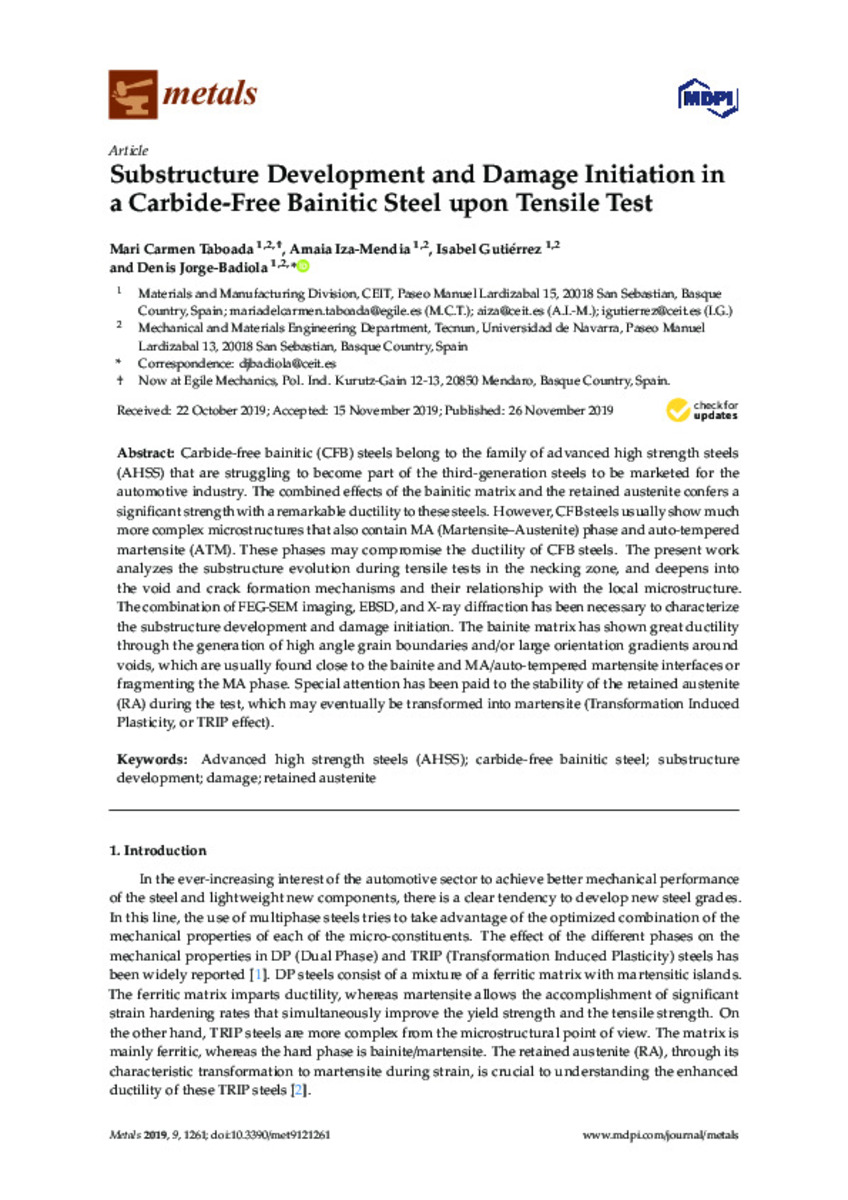Full metadata record
| DC Field | Value | Language |
|---|---|---|
| dc.creator | Taboada-Legaza, M.C.(Maria del Carmen) | - |
| dc.creator | Iza-Mendia, A. (Amaia) | - |
| dc.creator | Gutiérrez, I. (Isabel) | - |
| dc.creator | Jorge-Badiola, D. (Denis) | - |
| dc.date.accessioned | 2022-01-17T11:50:23Z | - |
| dc.date.available | 2022-01-17T11:50:23Z | - |
| dc.date.issued | 2019 | - |
| dc.identifier.citation | Taboada Legaza, M.C.(Maria del Carmen); Iza-Mendia, A. (Amaia); Gutiérrez, I. (Isabel); et al. "Substructure development and damage initiation in a carbide-free bainitic steel upon tensile test". Metals. 9 (12), 2019, 1261 | es |
| dc.identifier.issn | 2075-4701 | - |
| dc.identifier.uri | https://hdl.handle.net/10171/62730 | - |
| dc.description.abstract | Carbide-free bainitic (CFB) steels belong to the family of advanced high strength steels (AHSS) that are struggling to become part of the third-generation steels to be marketed for the automotive industry. The combined effects of the bainitic matrix and the retained austenite confers a significant strength with a remarkable ductility to these steels. However, CFB steels usually show much more complex microstructures that also contain MA (Martensite–Austenite) phase and auto-tempered martensite (ATM). These phases may compromise the ductility of CFB steels. The present work analyzes the substructure evolution during tensile tests in the necking zone, and deepens into the void and crack formation mechanisms and their relationship with the local microstructure. The combination of FEG-SEM imaging, EBSD, and X-ray diffraction has been necessary to characterize the substructure development and damage initiation. The bainite matrix has shown great ductility through the generation of high angle grain boundaries and/or large orientation gradients around voids, which are usually found close to the bainite and MA/auto-tempered martensite interfaces or fragmenting the MA phase. Special attention has been paid to the stability of the retained austenite (RA) during the test, which may eventually be transformed into martensite (Transformation Induced Plasticity, or TRIP effect). | es_ES |
| dc.description.sponsorship | This work has been carried out in the framework of the BaseForm and BAICONFORM projects. BaseForm project has received funding from the European Union’s Research Fund for Coal and Steel (RFCS) research program under grant agreement #RFCS-CT-2014-00017, whereas BAICONFORM project has been supported by Spanish Ministry of Competitiveness and Economy under the contract MAT 2016-81031-R. | es_ES |
| dc.language.iso | spa | es_ES |
| dc.publisher | MDPI AG | es_ES |
| dc.rights | info:eu-repo/semantics/openAccess | es_ES |
| dc.subject | Advanced high strength steels (AHSS) | es_ES |
| dc.subject | Carbide-free bainitic steel | es_ES |
| dc.subject | Substructure development | es_ES |
| dc.subject | Damage | es_ES |
| dc.subject | Retained austenite | es_ES |
| dc.title | Substructure development and damage initiation in a carbide-free bainitic steel upon tensile test | es_ES |
| dc.type | info:eu-repo/semantics/article | es_ES |
| dc.description.note | Licensee MDPI, Basel, Switzerland. This article is an open access article distributed under the terms and conditions of the Creative Commons Attribution (CC BY) license (http://creativecommons.org/licenses/by/4.0/). | es_ES |
| dc.identifier.doi | 10.3390/met9121261 | - |
| dadun.citation.number | 12 | es_ES |
| dadun.citation.publicationName | Metals | es_ES |
| dadun.citation.startingPage | 1261 | es_ES |
| dadun.citation.volume | 9 | es_ES |
Files in This Item:
Statistics and impact
Items in Dadun are protected by copyright, with all rights reserved, unless otherwise indicated.






